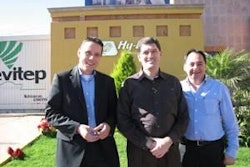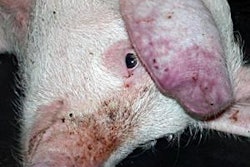Footpad dermatitis (FPD) is a common condition affecting broilers and turkeys and is known by a variety of names including pododermatitis and paw burns, all of which refer to a type of contact dermatitis on the footpad and toes. Prior to the mid 1980s, chicken paws were of little economic value and were rendered with feathers, blood and other unsalable portions of the chicken. Rendering prices for these by-products were roughly $0.01/lb in the mid 1980s.
Chicken paw prices have skyrocketed due to an insatiable export demand for high quality paws, transforming this product into the third most important economic part of the chicken behind the breast and wings. In 2008, the USA exported 928,000,000 lbs of chicken paws to China alone, worth about $280,000,000. The state of Georgia alone exported nearly $75,000,000 worth of paws. However, this is only between 40% and 50% of the paws that actually come into the processing plants. It has been estimated that every year the U.S. poultry industry loses roughly $250-300 million and the Georgia poultry industry loses roughly $75-100 million from downgraded and condemned paws. Paws are condemned for a variety of reasons that include paws from condemned carcasses, plant machinery mutilations, or FPD lesions.
Roughly 99% of these condemned paws are a result of FPD lesions. Not only is FPD a problem to the poultry industry because of revenue loss due to product downgrades and condemnations, it is currently being used as an indicator of bird welfare in animal welfare audits. Improving foot health not only provides opportunity for increased profit from more exportable chicken paws, but also ensures that the poultry industry continues to meet current animal welfare standards.
Litter Moisture
Recent work at UGA has focused on environmental factors, specifically looking at the relationship between litter moisture, litter depth and paw quality. Previous work has reported contradicting results with regards to litter depth and paw quality. Some research has shown that paw quality is better with deeper litter and others have shown it is best with shallow depths. Figures 1 and 2 illustrate the influence of litter depth on litter moisture and FPD scores. In this study, as the depth of litter increased, litter moisture decreased, and paw quality subsequently improved.
Wet litter has been shown by itself to cause ulceration of broiler foot pads. Lesions have been found to be more severe as litter moisture increases, especially when the litter is wet and droppings are sticky. Similar to findings with broilers, turkeys raised on wet litter have higher rates of FPD than those raised on dry litter. Continually standing on wet litter causes the footpad to soften and become more prone to damage, predisposing the bird to developing FPD. This is similar to a person staying in the swimming pool too long and getting wrinkly, soft skin on their toes and fingers. Drying out the litter and moving birds from wet litter to dry litter has been shown to reverse the severity of FPD.
Litter management
Litter plays an important role in moisture management within the broiler house. Basically, it acts as a sponge absorbing moisture and allowing for the dilution of fecal material. Just as with a sponge, the same is true with litter. Thicker bases of litter allow for more water retention and dissipation away from the surface where it comes into contact with birds. Litter must not only be able to absorb lots of moisture, but it should also have a reasonable drying time to get rid of that moisture.
Bedding material has become more expensive and, as a result, there are situations where inadequate amounts of shavings are being placed in broiler houses. Litter sometimes may be spread unevenly throughout the house, being much thicker in the middle than along the sides. Making sure litter is evenly spread out throughout the entire house is critical to prevent “slicking over” of the litter along the sidewalls. Ultimately the bedding material used depends on cost and availability.
Regardless of the source of bedding, when possible, use materials with smaller particle sizes, as they have been shown to produce better paws.
Litter management between flocks
If broiler houses are completely cleaned out between flocks, a minimum of three to four inches of litter is needed to handle the moisture throughout the flock. If on a built-up litter program, it is important to remove the caked litter to allow the litter base to dry before chicks are placed. Running fans during the day will remove moisture from the litter more rapidly.
There are several methods commonly used to manage litter between flocks such as tilling, removing cake and top-dressing, and windrowing. Six commercial 40 x 500 ft broiler houses were used to evaluate how litter management in between flocks would influence the incidence of FPD. The three litter methods used were cake removal, complete cleanout and windrowing. Each treatment was applied to two houses. The results indicated that the windrowed houses produced more Grade A and B paws in the processing plant than did caked and cleaned-out houses (Figure 3).
Drinker management
Proper drinker line management according to manufacturer’s guidelines can prevent excessive moisture from being added to the litter. Drinkers that are too low or have the water pressure set too high tend to result in wetter floors. Water lines that may have a biofilm or other particulates can result in leaky nipples, which will also increase litter moisture. Regular flushing and sanitizing the drinker system will reduce water leakage. This will keep litter drier and improve its quality, subsequently resulting in better paw quality.
Managing the moisture underneath the water and feed lines is essential due to the fact that the birds spend the majority of their time in this area. Keeping litter dry in this area can reduce problems not only from FPD but also from hock and breast burns as well.
Ventilation
If relative humidity (RH) is not currently being monitored in broiler houses, it should be used as a house management tool. A main objective of minimum ventilation is to control house moisture with the goal being to keep the RH between 50% and 70%.
More incidences of FPD and hock lesions have been observed in cold weather compared to warm weather and have a high correlation with relative humidity in the broiler house. These seasonal effects are related to the increased relative humidity in broiler houses that are due to reduced ventilation during cold weather. Circulation fans and attic inlets have been proven to promote dry floors in cold weather.
Bird density
Bird distribution through the house plays a large role with litter moisture. The sudden onset of wet litter associated with higher bird densities in one area of a house compared to another is considered to have a large influence on the development FPD. Litter conditions deteriorate rapidly as litter moisture increases with increased stocking density. As stocking density increases, water consumption increases per bird.
As birds drink more water, their feces become more watery and in turn contributes to overall litter moisture. One way to combat this problem is to properly utilize migration fences year round, even in cold weather months. Migration fences put in place shortly after birds are released to the entire house from partial house brooding will ensure that they are evenly spaced out throughout the house, allowing for better litter management and temperature regulation.
One simple, cost effective way to monitor bird density in the house is to add additional water meters. Water meters for the front, middle, and back of the house can indicate bird densities by simply looking at daily water consumption. Higher consumption in one end of the house means that there are more birds there than in the other sections of the house.
Controlling litter moisture can be a difficult task for some poultry producers, especially when heating costs are high. Making sure to have a dry litter base of at least three inches at the start of the flock will provide an adequate “sponge” to handle the moisture. Proper housing and equipment management will allow for decreased RH inside the house and ultimately drier litter. Keeping litter drier can go a long way to producing a healthier, more profitable flock.















